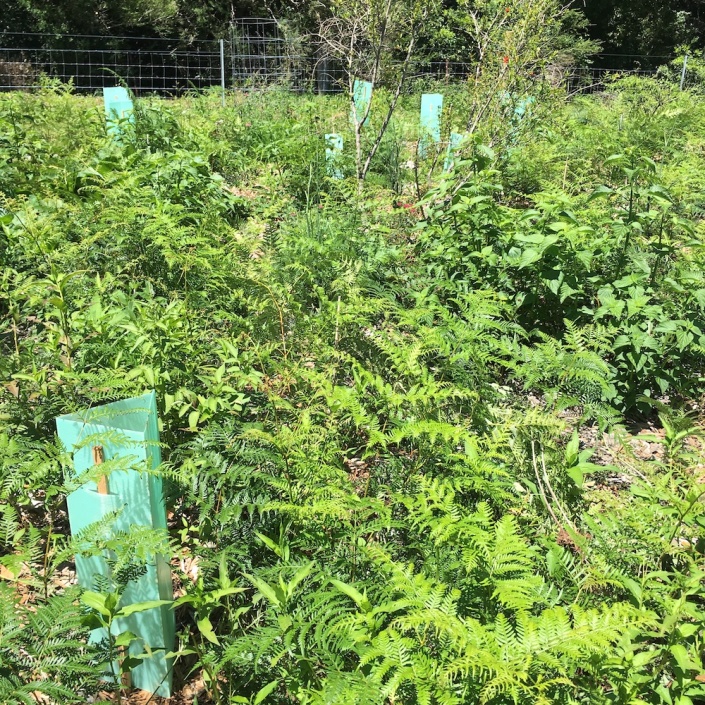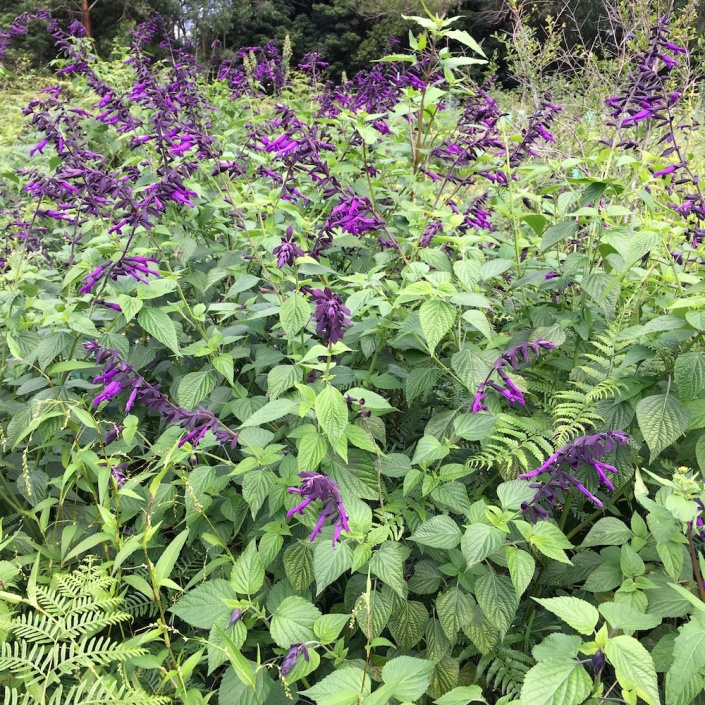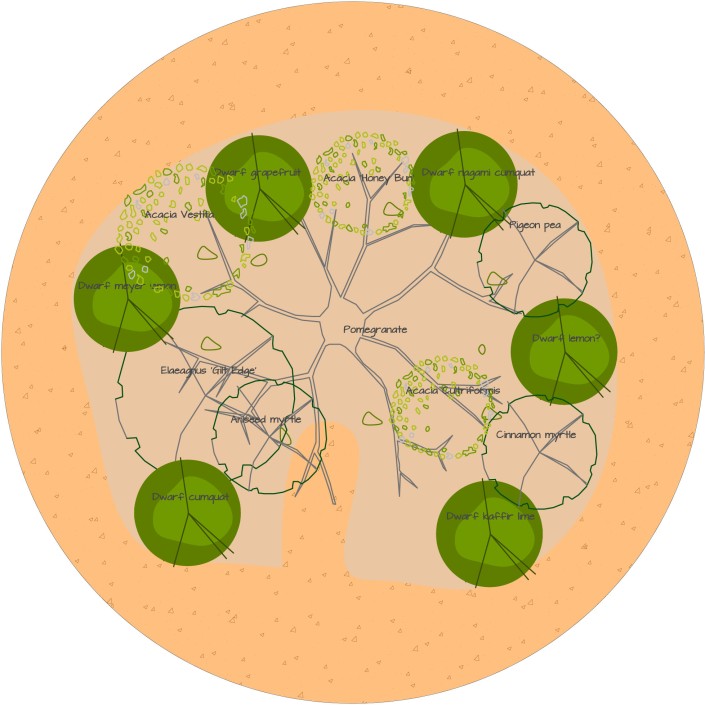citrus
Our first citrus patch: going to plan, or to ruin?
I could hear my neighbours thinking, when I proudly showed off our first citrus patch:
“This is what he’s been blogging about?!? What a mess! He must be mad!”
I can understand why they think that. The mainstream advice for an orchard, described in the most recent Gardening Australia magazine, is: “space the trees widely enough apart that you can easily mow between them”.
This isn’t what we’ve done. Instead, we’ve been creating a citrus guild.
To recap: the goal is to plant around the citrus tree with a variety of beneficial plants, bringing nutrient up from the soil, attracting beneficial bugs, and controlling grass (the enemy of all fruiting trees).
This is was my sketch of what it would look like:

But seeing the reality, you can understand why our neighbours are having second thoughts:

The growth has been extraordinary, a testament to the quality of our soil, and the benefits of breaking up compaction from years of horses grazing. Still, it’s hard to even spot the dwarf citruses amongst everything else.
The rapid growth of the bracken ferns has been a surprise, but I think in a good way. Since these ferns are known to act as ‘dynamic accumulators’, bringing up nutrients from the soil, they seem like an ideal groundcover. The grass certainly doesn’t stand a chance against it.
The salvias have pushed through and are flowering profusely. The rue, yarrow and fennel are all flowering to the benefit of beneficial bugs. The comfrey is growing, but is struggling against the bracken ferns, so we’ll see how that goes.

The citrus trees all suffered heavy transplant shock, but I’m hopeful they’ll start to take off in earnest next season, pushing above the ferns. The pomegranate at the centre of the patch also hasn’t thrived, but we have just had the driest summer in 20 years, so I’m hopeful for next year.
Watch this space, and I’ll continue to report on the journey of our edible forest garden patches … to success, or ruin.
(I’ll also post some aerial photos and videos shortly, which will give another perspective on how it’s progressing.)
Second citrus patch planted

Following on from our first patch of dwarf citrus, a family work gang has helped us plant out our second patch. This is of full-sized citrus, with supporting guild.
A few notes:
- With full-sized rather than dwarf citrus, patch 2 is a little under twice the size of patch 1.
- The ‘spine’ of the planting are three Elaeagnus Ebbingei a nitrogen-fixing plant that increases the fertility of fruit trees, and is highly-recommended for permaculture gardens.
- There’s a mix of native citrus (eg finger lime), introduced citrus (eg navel orange) and a few that are hybrids of the two (eg sunrise lime).
- I’ve snuck a few berry bushes into the understory on the Eastern side (currants and gooseberry). I want to test how they perform in increasing shade, as well as seeing whether all the fruit is eaten by birds, etc. Consider it a living experiment 😉
- As before, everything is sheet mulched, with a bunch of ‘in-fill’ plants to go in shortly to shade out any weeds.
With Spring coming, lets see how this patch goes!
First step towards an edible forest garden
As blogged about previously, our long-term goal for our South Coast property is to create an “edible forest garden“, following the books by Dave Jacke.
This week we took the first steps towards this big vision, with the planting of our first fruit trees.
The trees were all transplanted from Lewisham, with the bulk being citrus trees:
- Ruby grapefruit (dwarf)
- Cumquat x 2 (dwarf)
- Meyer lemon x 2 (dwarf)
- Kaffir lime (dwarf)
- Pomegranate (full-sized)
- Aniseed myrtle & Cinnamon myrtle
- Acacia (various, all shrubs rather than full-sized trees)
The plantings were carefully designed in advance to ensure that we get the most out of the trees, with the least maintenance work:

The design was laid out accurately on the ground using triangulation, to ensure that reality matched the plan.

After planting, the patch was sheet mulched, with a layer of cardboard covered by hardwood chip mulch. This should keep the weeds down long enough for the cover crops to do their work.

A few notes on the approach, with references back to Jacke’s book:
- The planting is done in patches, with are then combined to create the overall garden design.
- In this instance, it’s a polyculture patch (design pattern #44 from the book), which is a set of complementary plants that support and assist each other.
- As outlined in our post on citrus guilds, there’s a big focus on nitrogen-fixing plants to support the hungry fruit trees.
- The diagram above shows the eventual size of the trees (which will be some years off), and to achieve this an approach of instant succession (pattern #31) has been taken. This involves interplanting the gaps in the short term, to direct the eventual outcome.
- There are at least three layers in the patch (pattern #38), from ground covers, to the dwarf citrus up to the pomegranate (which while full-sized, is deciduous).
- A lumpy texture (pattern #39) of larger and smaller plants gives better light access, and confuses the pests.
- I’ve used a number of native species (pattern #43), including acacias (for nitrogen-fixing), plus aniseed and cinnamon myrtles (for culinary purposes).
- Underneath all the plants will be a thick ground-cover layer (pattern #49) that will be a mix of flowering plants to attract insects (pattern #42), and further nitrogen-fixers.
- The patch was fenced, with five strands of tensioned wire. This should deter the wallabies and wombats (note I didn’t say stop the animals, as that would be optimistic!).
All the preparation and planting work was knocked off by dad and myself in three days, making it about a man-week of work in total.

Phew! It’s been hard (but rewarding) work this week to get our first patch in place. I’m sure there will be huge successes and crushing failures to come, watch this space!
Limoncello
Earlier this year we had a glut of lemons, so I decided to make Limoncello as an experiment. I don’t remember where I found the recipe (it was many months ago when this experiment took place!) but it went something like this:
Ingredients
- 5 lemons
- 1 bottle of vodka
- 200g sugar
Method
- Zest the lemons. Mix the lemon zest with the vodka.
- Add a little bit of lemon juice.
- Close the lid and store it for 2 weeks.
Two weeks later
- In a saucepan, dissolve the sugar over low heat in 160ml of water.
- When the syrup is cool, add it to the vodka.
- If you want to, you can strain the Limoncello to remove some or all of the lemon zest.
- Store for another 4 weeks to allow the flavours to mature (hence why I’m only drinking it now!).
This limoncello is delizioso! It’s best served from the freezer and/or over ice, and a great way to use up some of your excess lemon crop.
A permaculture citrus guild (in Australia)
At Lewisham House, we love growing citrus. But it’s a hungry crop, and high maintenance.
Now one of the core concepts in permaculture is that of a “guild”. The idea is that instead of just planting a tree by itself, you plant it with a community (a “guild”) of other plants, which provide supporting services. This might include extra nutrients, attractants for beneficial bugs, and the like.
If you search the net, you’ll find plenty of diagrams for apple tree guilds, hazelnut guilds, and other northern hemisphere deciduous trees. But not for citrus trees (that I could find).
So I did a fair bit of reading and thinking, and these are my draft citrus guilds, for Australian warm temperate conditions. All feedback welcome!
Design principles
- Citrus trees are gross feeders. So the guild has to produce a lot of nitrogen, and other fertilisers, to support the citrus.
- Design for full-sized and dwarf trees. Dwarfed citrus trees are widely available, and can be very useful in a permaculture context.
- Minimal maintenance. Ideally, once setup, the guild runs itself.
- Plants have to be available in Australia. There are plenty of great permaculture plants (like goumi), which I just can’t find in Oz.
- Australian natives wherever possible. Rainforest plants are particularly useful, as they’re acclimatised to shade and competition.
- Warm temperate or sub-tropical. Some of the species I’ve chosen would likely struggle in colder conditions.
Citrus guild (full-sized trees; version 1.0)


Citrus guild (dwarf trees; version 1.0)


Notes and questions
- I’ve packed in as many nitrogen-fixing species that I can, with a mix of native and introduced species.
- Acacia (wattle) are great nitrogen-fixers, and they thrive in most conditions. But the big question from what I’ve read is: do acacias release that nitrogen into the soil for the benefit of other trees, or just keep it for themselves. An answer please! (I’ve done a lot of looking, and I’m still uncertain.)
- A linear arrangement is just one possibility, and it happened to match some other design work that I was doing at the time.
- Does this guild work in practice? I’m just starting to experiment in the real world, so all feedback and suggestions welcome.
- Have I missed any good plants that can serve a productive purpose in the guild? Again, all suggestions encouraged.
- Are there other citrus guild drawings that I’ve missed? Please post links in the comments below.
Why you shouldn’t plant citrus trees in the verge

Before Lewisham, we lived in a unit in Chippendale. Surrounded by the local guerrilla gardening of the verge, we were equally enthusiastic when we moved into our new house.
We remain strong supporters of the principle of gardening the verge (nature strip). We’ve learned along the way, however, a bit about what works and what doesn’t.
What works in the verge
There are many possibilities for gardening the verge, while staying in local council guidelines.
“Pick and come again” mediterranean herbs work particularly well. They’re tough, attractive, and useful for office workers heading home to make their evening meal. Olive trees and bay trees also work well, acclimatised as they are to tough conditions.
There are plenty of native plants that work well in the verge, from low-running ground-covers and strap-leaf grasses, through to hardy bushes and small trees. (We’re quite pleased with our native verge.)
What doesn’t work in the verge
Our biggest lesson is that citrus trees don’t work well in the verge. Since this is the hardest learned lesson for us, it’s worth sharing a few specific reasons:
- Citrus trees are gross feeders. That is, they require a lot of food, throughout the year. Without this, they remain stunted and fruit-less. (For example, for us to get lots of limes, we greatly ramped up our feeding regimen.)
- Citrus are attacked by bugs and diseases. There’s practically nothing that they aren’t attacked by, including citrus leaf miners, stink bugs, aphids, thrips and citrus gall moth, to name just a few.
- Citrus aren’t set-and-forget. For the reasons listed above, citrus need constant monitoring and care, for their entire lifetime.
- They get stolen. Mirroring the experience in Chippendale, three of our four citrus trees were stolen in the first fortnight, the last being left only because it looked so poor.
- People are impatient. While the whole idea of edible plants in the verge is to share the bounty, we’ve found that the fruits get taken well before they’ve even ripened.
- People are careless. More often than not, a whole branch will be ripped off, rather than a single fruit twisted free.
In short, don’t plant citrus. Beyond this, each local council will have guidelines about what not to plant. Large street trees are typically seen, for example, as the sole domain of the council to plant.
But there are plenty of other options! May your verge live well and prosper.
Fighting off fruit flies

Each year, we seem to have a different plague of pests. Last year it was fruit flies. The year before last it was cabbage moths and citrus leaf miner. I guess it’s probably to do with the weather conditions leading up to summer.
This year we’ve taken a more proactive approach to dealing with fruit flies, as our citrus is finally cropping well, and we’ve got a good number of apples growing out the back.
The photo above shows the home-made traps, made of plastic food containers with slots cut in the side. These are filled with Wild May Fruit Fly Attractant. This lures in the male fruit fly, who then drowns in the liquid.
It’s cheap, and as you can see in the photo, effective. Let’s see if it makes enough of a difference!
Lots of limes

We’ve been pretty quiet about our citrus growing on this blog so far, despite having a lemon, lime, two oranges and a grapefruit in the ground. Why? Let’s just say, they didn’t prosper in their first 18 months.
What turned things around was some reading about their hungry nature. We’d been giving them regular handfuls of citrus fertiliser, but they were still struggling, barely growing, and not fruiting.
Then I read the following from two different sources:
Citrus trees need 0.5kg of fertiliser for each year of age … per year.
Eeek! That’s a lot of fertiliser, certainly a lot more than the handfuls I was applying.
Ramping up the feeding quickly showed the value of this advice, however. All the trees starting growing strongly, with the yellow vanishing from the leaves, and flowers sprouting. They’re now well on their way, and I’m expecting good things from them over the next few years.
The photo above shows our first real harvest of citrus. Noting that the lime tree was weighed down by fruit, I harvested a bucket’s worth. This turned out to be 45 limes, from a tree not as high as my shoulder. That’s more like it 🙂
Planting under citrus trees
When I planted our citrus trees, I was well aware of the need to keep the grass away, so it doesn’t compete with the shallow tree roots. So I lay down a thick layer of bark mulch (being careful to keep the lower trunk clear).
Some time later, I read through the Introduction to Permaculture by Bill Mollison. It highlights the benefit of “companion planting” out a whole under-story of plants under citrus trees, increasing productivity and actually helping the trees.
This is what seems most applicable to the urban garden:
- spring bulbs
- comfrey
- dandelion
- globe artichoke
- fennel
- dill
- tansy
- carrot
- catnip
- daisy
- nasturtium
- flowering ground covers
I’ve started with planting out some nasturtium seeds (which produce edible flowers and leaves), as well as dill. I’ll probably add fennel and comfrey down the track…
Lemons into the nature strip

A few weeks ago I ordered two dwarf myer lemons from Perry’s Fruit and Nut Nursery in SA. These are your typical Australian backyward lemon, but on “Flying Dragon” roostock, which according to the nursery is the only “true” dwarfing stock.
This morning both lemons went into the nature strip, in front of our house. Give them a year, and they should be producing prolific fruit all year round (fingers crossed!). Of course, many (most?) of the lemons will be picked by passer-byers, but that’s OK. Particularly if it distracts them from raiding our front garden veges…
